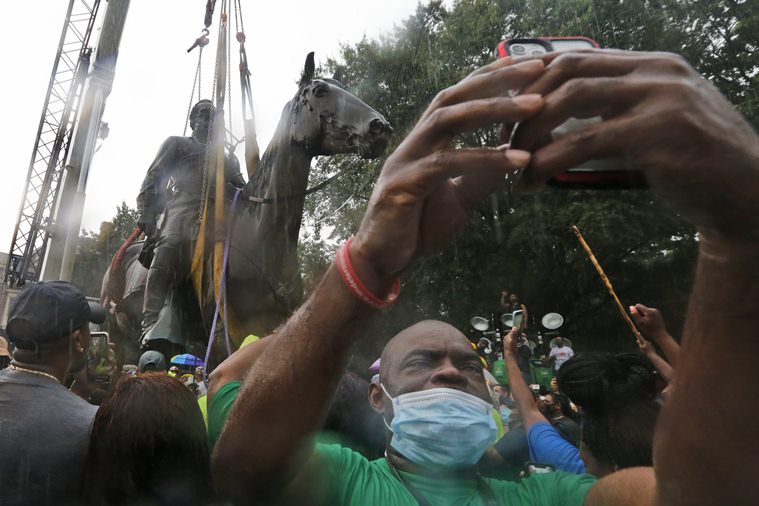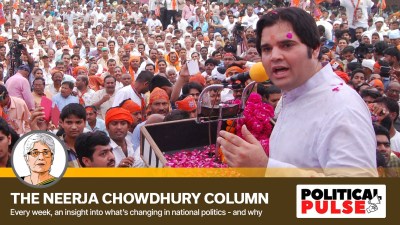- India
- International
Understanding the politics of pulling down statues: what does it convey, and what does it miss?
Statues representing oppression and injustice are being toppled around the world. Is their destruction the only option or is there a case to be made for conservation as well?
 Statues on the exterior of the Surrogate’s Court are seen vandalised across from an area being called the “City Hall Autonomous Zone” that has been established to protest the New York Police Department and in support of “Black Lives Matter” near City Hall in lower Manhattan, in New York City. Reuters
Statues on the exterior of the Surrogate’s Court are seen vandalised across from an area being called the “City Hall Autonomous Zone” that has been established to protest the New York Police Department and in support of “Black Lives Matter” near City Hall in lower Manhattan, in New York City. Reuters
In the wake of the Black Lives Matter movement in the USA, as people around the world begin to reckon with the histories of discrimination and dehumanisation that lie beneath stories of nation-building, public statues of prominent historical figures have become a target of popular anger. In the USA, African Americans have long been demanding the removal of public statues celebrating slave owners and confederate heroes, including Jefferson Davis, while Native Americans have objected to the many statues of Christopher Columbus, who they accuse of being responsible for the genocide of their ancestors, that dot the country.
In the recent protests, many of these statues have either been pulled down by protesters or are being removed voluntarily by the people and institutions who put them up in the first place. One of these is a statue of former president Theodore Roosevelt which depicts him astride a horse and flanked on either side by an African man and an Native American man. The American Museum of Natural History in New York, at whose entrance this statue stood, had requested its removal because, as the institution said in a statement, it “communicated a racial hierarchy”.
Also Read | #BlackLivesMatter: ‘There has never been a reckoning for (American) policing’s slave-patrol origins’
Establishing the order
Public statues — whether of actual people or of figures meant to represent abstract notions such as God, national pride, peace — have been an important propaganda tool for centuries, an assertion of power used to establish social and political hierarchies. Between 30 BCE and 330 CE, public statues of the Emperor, as well as prominent citizens, helped keep the Roman Empire unified and promote the idea of Pax Romana. Centuries later, as the British Empire grew, statues of British rulers, generals and law-makers, were put up across the colonies, establishing their apex position in the political and social hierarchy.
Statues didn’t just play a role in empire building; they were crucial in other kinds of propaganda as well. Nazi Germany, for example, drew heavily on the power of propaganda art, including not just sculpture, but also painting, music and cinema. Hitler had a well-documented contempt for the modernist and expressive in art, dismissing it as “degenerate” and as an “act of aesthetic violence by the Jews against the German spirit”, as historian Henry Grosshans wrote in Hitler and the Artists. Instead, the Third Reich commissioned works that pushed the new German ideals of masculinity and heroism and which drew on “pure” classical styles to reflect Aryan racial purity.

In the Soviet Union, similarly, a realistic style called Socialist Realism developed, which was meant to idealise Communist values. Apart from paintings and posters, statues representing the worker and the peasant, as well as abstract ideas such as youth and vigour were commissioned. Statues of Lenin and, later, Stalin, were put up everywhere as reminders of the power of the state.
 A protester takes a selfie as workers remove the statue of Confederate General Stonewall Jackson from it’s pedestal in a driving rain storm on Monument Avenue Wednesday July 1, 2020, in Richmond, Va. As of July 1, 2020 a new law allowed localities to remove statues. (AP Photo/Steve Helber)
A protester takes a selfie as workers remove the statue of Confederate General Stonewall Jackson from it’s pedestal in a driving rain storm on Monument Avenue Wednesday July 1, 2020, in Richmond, Va. As of July 1, 2020 a new law allowed localities to remove statues. (AP Photo/Steve Helber)
The case for iconoclasm
Iconoclasm — drawn from the Late Greek (late antiquity and Byzantine period) word eikonoklastes, meaning “breaker of icons” — has a long history going at least as far back as Ancient Egypt to when pharaoh Akhenaten abandoned traditional polytheism and ordered the destruction of the images of all gods except that of the sun disc, Aten.
Instances of iconoclasm appear throughout ancient and medieval history, the most famous being the Byzantine Iconoclasm in the 8th and 9th century CE when emperor Leo III prohibited the worship of icons (or idols), leading to the destruction of icons venerated by many.
Modern history, too, is replete with images of iconoclasm, albeit more explicitly political than religious. In 2003, after the invading coalition forces led by the US captured Baghdad, one of the most powerful images to emerge was that of the statue of Saddam Hussein being pulled down. Photographs that show Iraqis beating the statue with their shoes speak volumes about the cathartic power of destroying physical reminders of oppression. Similar destruction of the visual reminders of the Third Reich had taken place immediately after the Second World War in Germany and in the aftermath of the dissolution of the Soviet Union.
It’s not surprising then that as the Black Lives Matter movement reverberates around the world, among the most powerful images are those of statues being pulled down or defaced, including that of Confederate heroes in the USA and the slave trader Edward Colston in Bristol, UK. Architect and conservationist AGK Menon says, “Whether it is the statues of confederate soldiers in the USA or the statue of Colston, their destruction is the visceral response to racism that exists even today. It’s a lived reality for the protesters.”
Also in Explained: Why a capital ‘B’ in ‘Black’ is culmination of very long journey
The case for conservation
Menon, however, believes that there is a case to be made for the conservation of statues that stand as physical reminders of past injustices and oppression. “Evil history is still history,” he says, “In Germany, school children are now taught about the Holocaust, something they are ashamed of. Gernams said we should not forget what happened and shouldn’t allow it to ever happen again. That is the purpose of conservation. Unless you conserve Auschwitz, how will you know? How will people remember what happened? As conservationists, we don’t judge. Our job is to retain memory, whether it’s good, bad or indifferent.”
Mumbai-based indologist and art historian Sandeep Dahisarkar says, “While most of the statues we see in Mumbai, for example, were put up during the colonial period, they were not just symbols of power, they also carry great art value. They were made by great academic sculptors and were very expensive at the time. Not many sculptors in India can work with marble like that now. So we have much to learn from them.”
📣 Express Explained is now on Telegram. Click here to join our channel (@ieexplained) and stay updated with the latest
As an example, he points to two prominent colonial-era statues of King George V in Mumbai. “One depicted him as the King Emperor and stood at the Gateway of India. It has now been removed and in its place is the statue of Chhatrapati Shivaji Maharaj. But instead of putting it out of sight, the statue could have been placed next to another statue of George V that stands on the premises of the Chhatrapati Shivaji Maharaj Vastu Sangrahalaya. This one depicts his younger self, as the Prince of Wales, and it would have been extremely useful for art students to compare the two statues and learn from them, how age and position are depicted in sculpture.”
Additionally, as Menon points out, the relevance of statues representing terrible history doesn’t end with their destruction. “The statue of Colston was thrown into the water, but that’s not the end of the story. It was then dredged out and the city of Bristol is going to put it up again, but with all the graffiti by protestors as well as the rope around its neck, intact. That’s because these protests, too, have become part of the history that the statue now represents,” he says.
EXPRESS OPINION
Apr 25: Latest News
- 01
- 02
- 03
- 04
- 05









































